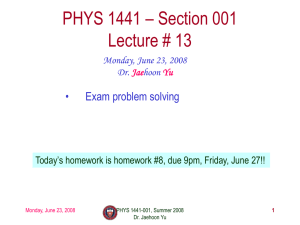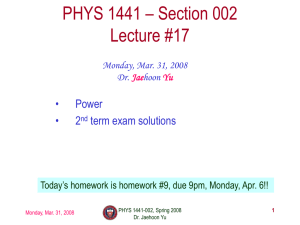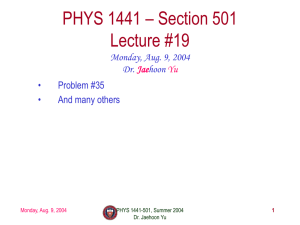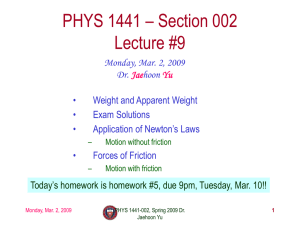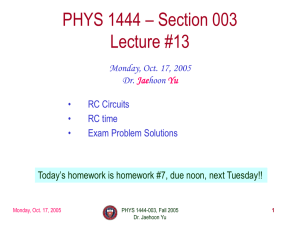Monday, June 8, 2009
advertisement
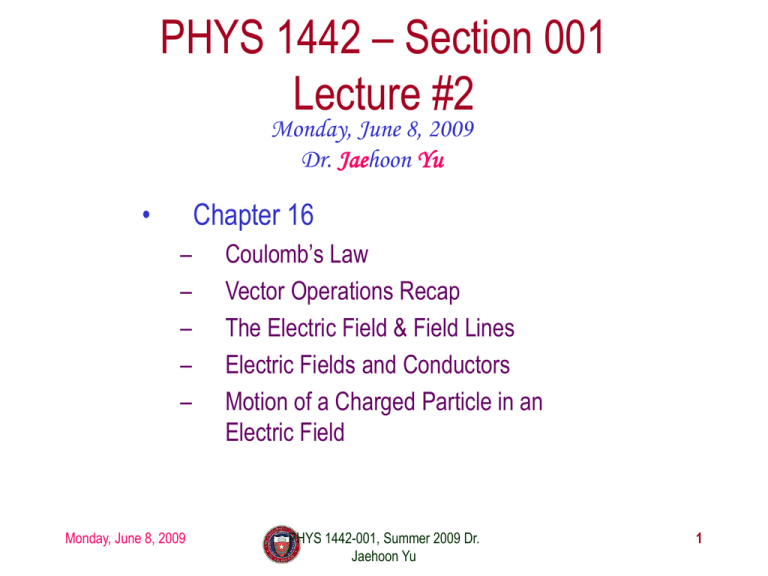
PHYS 1442 – Section 001 Lecture #2 Monday, June 8, 2009 Dr. Jaehoon Yu • Chapter 16 – – – – – Monday, June 8, 2009 Coulomb’s Law Vector Operations Recap The Electric Field & Field Lines Electric Fields and Conductors Motion of a Charged Particle in an Electric Field PHYS 1442-001, Summer 2009 Dr. Jaehoon Yu 1 Announcements • Your five extra credit points for e-mail subscription extended till midnight Wednesday, June 10. Please take a full advantage of the opportunity. – Five of you have subscribed so far. Thank you!!! • 11 of you have registered in the homework system. – Fantastic job!! – You need my enrollment approval… So move quickly… – Remember, the due is 9pm Thursday. • Reading assignment: CH16 – 10, 16 – 11, 16 – 12 • Quiz beginning of the class this Wednesday, June 10 – Appendix A1 – A8 and CH16 Monday, June 8, 2009 PHYS 1442-001, Summer 2009 Dr. Jaehoon Yu 2 Special Project – Angels & Demons • Compute the total possible energy released from an annihilation of x-grams of anti-matter and the same quantity of matter, where x is the last two digits of your SS#. (20 points) – Use the famous Einstein’s formula for mass-energy equivalence • Compute the power output of this annihilation when the energy is released in x ns, where x is again the last two digits of your SS#. (10 points) • Compute how many cups of gasoline (8MJ) this energy corresponds to. (5 points) • Compute how many months of electricity usage it corresponds to (3.6GJ). (5 points) • Due by the beginning of the class Monday, June 15. Monday, June 8, 2009 PHYS 1442-001, Summer 2009 Dr. Jaehoon Yu 3 Special Project – Magnitude of Forces • What is the magnitude of the Coulomb force one proton exerts to another 1m away? (10 points) • What is the magnitude of the gravitational force one proton exerts to another 1m away? (10 points) • Which one of the two forces is larger and by how many times? (10 points) • Due at the beginning of the class Monday, June 22. Monday, June 8, 2009 PHYS 1442-001, Summer 2009 Dr. Jaehoon Yu 4 Induced Charge ground • We can induce a net charge on a metal object by connecting a wire to the ground. – The object is “grounded” or “earthed”. • Since it is so large and conducts, the Earth can give or accept charge. – The Earth acts as a reservoir for charge. • If the negative charge is brought close to a neutral metal – The positive charges will be induced toward the negatively charged metal. – The negative charges in the neutral metal will be gathered on the opposite side, transferring through the wire to the Earth. – If the wire is cut, the metal bar has net positive charge. • An electroscope is a device that can be used for detecting charge and signs. – How would this work? Monday, June 8, 2009 PHYS 1442-001, Summer 2009 Dr. Jaehoon Yu 5 Coulomb’s Law • Charges exert force to each other. What factors affect the magnitude of this force? – Any guesses? • Charles Coulomb figured this out in 1780’s. • Coulomb found that the electrical force is – Proportional to the multiplication of the two charges • If one of the charges doubles, the force doubles. • If both the charges double, the force quadruples. – Inversely proportional to the square of the distances between them. – Electric charge is a fundamental property of matter, just like mass. • How would you put the above into a formula? Monday, June 8, 2009 PHYS 1442-001, Summer 2009 Dr. Jaehoon Yu 6 Coulomb’s Law – The Formula Q11 Q22 Q F 2 r Formula Q1Q2 F k 2 r • Is Coulomb force a scalar quantity or a vector quantity? Unit? – A vector quantity. Newtons • Direction of electric (Coulomb) force is always along the line joining the two objects. – If the two charges are the same sign: forces are directed away from each other. – If the two charges are opposite sign: forces are directed toward each other. • Coulomb force is precise to 1 part in 1016. • Unit of charge is called Coulomb, C, in SI. • The value of the proportionality constant, k, in SI unit is k 8.988 109 N m2 C 2 • Thus, 1C is the charge that gives F~9x109N of Monday, 8, 2009 PHYS 1442-001, Summer 2009 Dr. forceJune when placed 1m apart from each other. Jaehoon Yu 7 Electric Force and Gravitational Force Q1Q2 F k 2 r Extremely Similar M1M 2 F G 2 r • Does the electric force look similar to another force? What is it? – Gravitational Force • What are the sources of the forces? – Electric Force: Charges, fundamental properties of matter – Gravitational Force: Masses, fundamental properties of matter • What else is similar? – Inversely proportional to the square of the distance between the sources of the force What is this kind law called? • Inverse Square Law • What is the difference? – Gravitational force is always attractive. – Electric force depends on the signs of the two charges. Monday, June 8, 2009 PHYS 1442-001, Summer 2009 Dr. Jaehoon Yu 8 The Elementary Charge and Permittivity • Elementary charge, the smallest unit charge, is that of an electron: e 1.602 1019 C – Since electron is a negatively charged particle, its charge is –e. • An object cannot gain or lose fraction of an electron. – Electric charge is quantized. • It changes always in integer multiples of e. • The proportionality constant k is often written in terms of another constant, ε0, the permittivity of free space. They are related k 1 4 0 and 0 1 4 k 8.85 1012 C 2 N m2. 1 Q1Q2 • Thus the electric force can be written: F 4 r 2 0 • Note that this force is for “point” charges at rest. Monday, June 8, 2009 PHYS 1442-001, Summer 2009 Dr. Jaehoon Yu 9 Example 16 – 1 • Electric force on electron by proton. Determine the magnitude of the electric force on the electron of a hydrogen atom exerted by the single proton (Q2=+e) that is its nucleus. Assume the electron “orbits” the proton at its average distance of r=0.53x10-10m. Using Coulomb’s law Each charge is F Q1Q2 Q1Q2 k 4 0 r 2 r2 1 Q1 e 1.602 1019 C and Q2 e 1.602 1019 C So the magnitude of the force is 1.6 10 C 1.6 10 0.53 10 m 19 Q1Q2 9 2 2 F k 2 9.0 10 N m C r 8.2 10 8 N Which direction? Monday, June 8, 2009 10 19 C 2 Toward each other… PHYS 1442-001, Summer 2009 Dr. Jaehoon Yu 10 Example 16 – 2 • Which charge exerts greater force? Two positive point charges, Q1=50μC and Q2=1μC, are separated by a distance L. Which is larger in magnitude, the force that Q1 exerts on Q2 or the force that Q2 exerts on Q1? Q1Q2 F12 k What is the force that Q1 exerts on Q2? L2 Q2Q1 What is the force that Q2 exerts on Q1? F21 k L2 Therefore the magnitudes of the two forces are identical!! Well then what is different? The direction. Which direction? Opposite to each other! What is this law? Newton’s third law, the law of action and reaction!! Monday, June 8, 2009 PHYS 1442-001, Summer 2009 Dr. Jaehoon Yu 11 Vector Additions and Subtractions • Addition: – Triangular Method: One can add vectors by connecting the head of one vector to the tail of the other (head-to-tail) – Parallelogram method: Connect the tails of the two vectors and extend – Addition is commutative: Changing order of operation does not affect the results A+B=B+A, A+B+C+D+E=E+C+A+B+D A+B B A • A = B A+B OR A+B B A Subtraction: – The same as adding a negative vector:A - B = A + (-B) A A-B • -B Since subtraction is the equivalent to adding a negative vector, subtraction is also commutative!!! Multiplication by a scalar is increasing the magnitude A, B=2A Monday, June 8, 2009 B 2A A PHYS 1442-001, Summer 2009 Dr. Jaehoon Yu B=2A 12 Example for Vector Addition A force of 20.0N applies to north while another force of 35.0N applies in the direction 60.0o west of north. Find the magnitude and direction of resultant force. F2 sin60o N F 2 1 F260o F cos60o 2 F F cos60 F sin 60 F E F12 F22 2F1F2 cos 60 20.02 35.02 2 20.0 35.0 cos 60 2325 48.2(N ) tan 1 tan 1 tan 1 Monday, June 8, 2009 2 F12 F22 cos 2 60 sin 2 60 2F1F2 cos 60 20 F1 2 2 F 2 sin 60 F 1 F 2 cos 60 35.0 sin 60 20.0 35.0 cos 60 30.3 38.9 to W wrt N 37.5 PHYS 1442-001, Summer 2009 Dr. Jaehoon Yu Find other ways to solve this problem… 13 Components and Unit Vectors Coordinate systems are useful in expressing vectors in their components y Fy (+,+) F (-,+) (Fx,Fy) (-,-) ur F Monday, June 8, 2009 (+,-) ur F 2 Fy ur F sin x Fx ur F cos Fx ur F cos F Fx2 Fy2 2 ur F sin cos 2 sin 2 PHYS 1442-001, Summer 2009 Dr. Jaehoon Yu } Components } Magnitude 2 ur F 14 Unit Vectors • Unit vectors are the ones that tells us the directions of the components • Dimensionless • Magnitudes are exactly 1 • Unit vectors are usually expressed in i, j, k or r r r i, j, k So the vector F can be re-written as Monday, June 8, 2009 ur ur r r ur r r F Fx i Fy j F cos i F sin j PHYS 1442-001, Summer 2009 Dr. Jaehoon Yu 15 Examples of Vector Operations Find the resultant force which is the sum of F1=(2.0i+2.0j)N and F2 =(2.0i-4.0j)N. r r r r ur ur ur F 3 F 1 F 2 2.0i 2.0 j 2.0i 4.0 j r r r r 2.0 2.0 i 2.0 4.0 j 4.0i 2.0 j N ur F 3 4.02 2.02 16 4.0 20 4.5(N ) tan 1 2.0 27o tan F3x 4.0 F3 y 1 Find the resultant force of the sum of three forces: F1=(15i+30j +12k)N, F2=(23i+14j -5.0k)N, and F3=(-13i+15j)N. ur ur ur ur r r r r r r r r F F 1 F 2 F 3 15i 30 j 12k 23i 14 j 5.0k 13i 15 j r r r r r r 15 23 13 i 30 14 15 j 12 5.0 k 25i 59 j 7.0k (N ) Magnitude Monday, June 8, 2009 ur D 25 59 7.0 65(N ) 2 2 2 PHYS 1442-001, Summer 2009 Dr. Jaehoon Yu 16 Example 16 – 3 • Three charges in a line. Three charged particles are arranged in a line as shown in the figure. Calculate the net electrostatic force on particle 3 (the -4μC on the right) due to other two charges. What is the force that Q1 exerts on Q3? F13x k Q1Q3 L2 9.0 10 9 N m2 C 2 4.0 10 C 8.0 10 C 1.2N k Q2Q3 L2 6 0.5m 2 What is the force that Q2 exerts on Q3? F23x 6 9.0 10 9 N m2 C 2 4.0 10 C 3.0 10 C 2.7 N 6 0.2m Using the vector sum of the two forces 6 2 Fx F13x F23x 1.2 2.7 1.5 N Fy 0 N F 1.5i (N ) Monday, June 8, 2009 PHYS 1442-001, Summer 2009 Dr. Jaehoon Yu 17 The Electric Field • Both gravitational and electric forces act over a distance without touching objects What kind of forces are these? – Field forces • Michael Faraday developed an idea of field. – Faraday argued that the electric field extends outward from every charge and permeates through all of space. • Field by a charge or a group of charges can be inspected by placing a small test charge in the vicinity and measuring the force on it. Monday, June 8, 2009 PHYS 1442-001, Summer 2009 Dr. Jaehoon Yu 18 The Electric Field • The electric field at any point in space is defined as the force exerted on a tiny positive test charge divide by the magnitude of the test charge F F qE – Electric force per unit charge E q • What kind of quantity is the electric field? – Vector quantity. Why? • What is the unit of the electric field? – N/C • What is the magnitude of the electric field at a distance r from a single point charge Q? F 1 Q kQq r 2 kQ 2 E 2 4 r q q r 0 Monday, June 8, 2009 PHYS 1442-001, Summer 2009 Dr. Jaehoon Yu 19 • Example 16 – 6 Electrostatic copier. An electrostatic copier works by selectively arranging positive charges (in a pattern to be copied) on the surface of a nonconducting drum, then gently sprinkling negatively charged dry toner (ink) onto the drum. The toner particles temporarily stick to the pattern on the drum and are later transferred to paper and “melted” to produce the copy. Suppose each toner particle has a mass of 9.0x10-16kg and carries the average of 20 extra electrons to provide an electric charge. Assuming that the electric force on a toner particle must exceed twice its weight in order to ensure sufficient attraction, compute the required electric field strength near the surface of the drum. The electric force must be the same as twice the gravitational force on the toner particle. So we can write Fe qE 2 Fg 2mg Thus, the magnitude of the electric field is E 2mg q Monday, June 8, 2009 2 9.0 1016 kg 9.8 m s 2 20 1.6 10 19 C PHYS 1442-001, Summer 2009 Dr. Jaehoon Yu 5.5 10 3 N C. 20 Direction of the Electric Field • If there are more than one charge, the individual field due to each charge is added vectorially to obtain the total field at any point. ETot E1 E2 E3 E4 .... • This superposition principle of electric field has been verified by experiments. • For a given electric field E at a given point in space, we can calculate the force F on any charge q, F=qE. – What happens to the direction of the force and the field depending on the sign of the charge q? – The two are in the same directions if q>0 – The two are in opposite directions if q<0 Monday, June 8, 2009 PHYS 1442-001, Summer 2009 Dr. Jaehoon Yu 21
